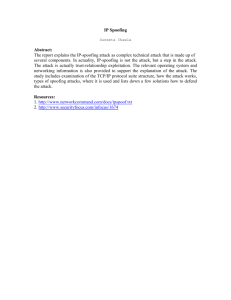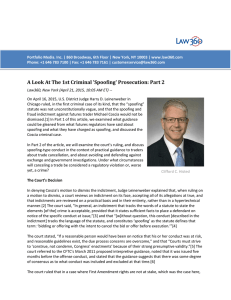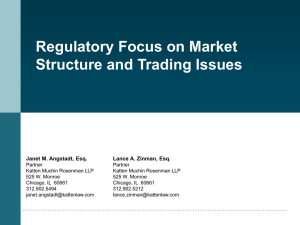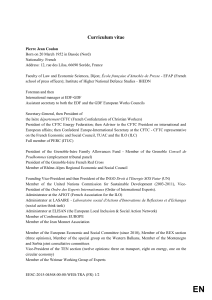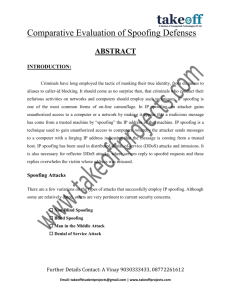Portfolio Media. Inc. | 860 Broadway, 6th Floor | New...
advertisement
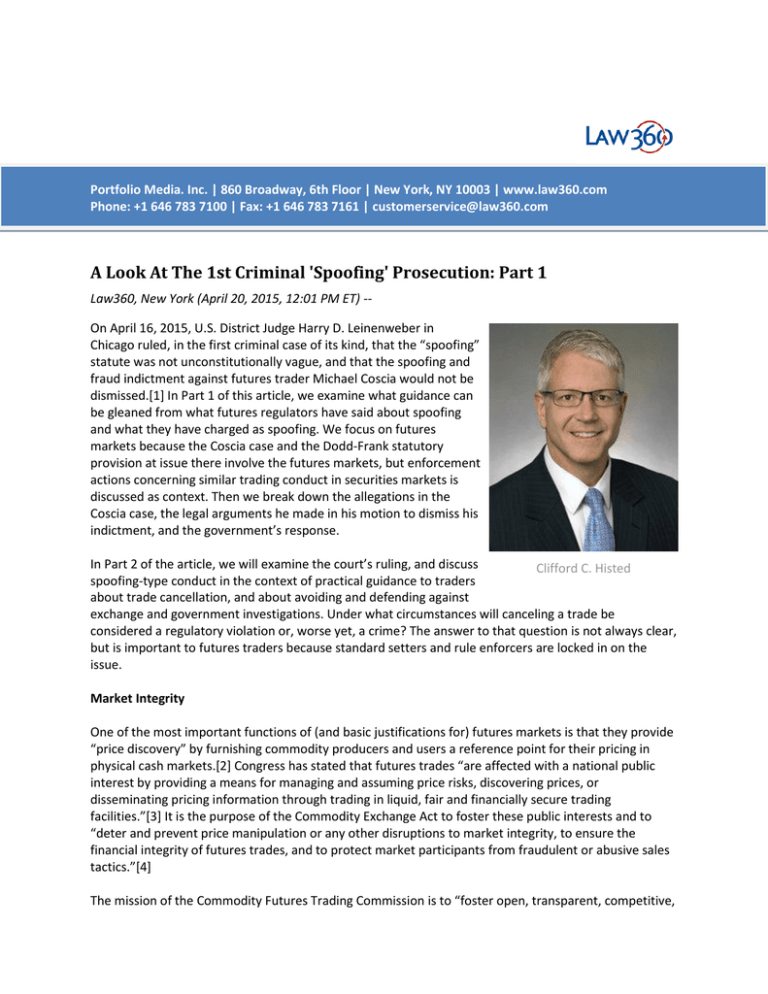
Portfolio Media. Inc. | 860 Broadway, 6th Floor | New York, NY 10003 | www.law360.com Phone: +1 646 783 7100 | Fax: +1 646 783 7161 | customerservice@law360.com A Look At The 1st Criminal 'Spoofing' Prosecution: Part 1 Law360, New York (April 20, 2015, 12:01 PM ET) -On April 16, 2015, U.S. District Judge Harry D. Leinenweber in Chicago ruled, in the first criminal case of its kind, that the “spoofing” statute was not unconstitutionally vague, and that the spoofing and fraud indictment against futures trader Michael Coscia would not be dismissed.[1] In Part 1 of this article, we examine what guidance can be gleaned from what futures regulators have said about spoofing and what they have charged as spoofing. We focus on futures markets because the Coscia case and the Dodd-Frank statutory provision at issue there involve the futures markets, but enforcement actions concerning similar trading conduct in securities markets is discussed as context. Then we break down the allegations in the Coscia case, the legal arguments he made in his motion to dismiss his indictment, and the government’s response. In Part 2 of the article, we will examine the court’s ruling, and discuss Clifford C. Histed spoofing-type conduct in the context of practical guidance to traders about trade cancellation, and about avoiding and defending against exchange and government investigations. Under what circumstances will canceling a trade be considered a regulatory violation or, worse yet, a crime? The answer to that question is not always clear, but is important to futures traders because standard setters and rule enforcers are locked in on the issue. Market Integrity One of the most important functions of (and basic justifications for) futures markets is that they provide “price discovery” by furnishing commodity producers and users a reference point for their pricing in physical cash markets.[2] Congress has stated that futures trades “are affected with a national public interest by providing a means for managing and assuming price risks, discovering prices, or disseminating pricing information through trading in liquid, fair and financially secure trading facilities.”[3] It is the purpose of the Commodity Exchange Act to foster these public interests and to “deter and prevent price manipulation or any other disruptions to market integrity, to ensure the financial integrity of futures trades, and to protect market participants from fraudulent or abusive sales tactics.”[4] The mission of the Commodity Futures Trading Commission is to “foster open, transparent, competitive, financially sound markets, to avoid systemic risk, and to protect the market users and their funds, customers, and the public from fraud, manipulation, and abusive practices related to derivatives and other products that are subject to the Commodity Exchange Act.”[5] The CFTC in turn requires futures exchanges to enact, monitor, and enforce compliance with rules prohibiting abusive trade practices, and promoting fair and equitable trading.[6] High-frequency trading is not and should not be illegal. The mere cancellation of trades is not spoofing, and is not illegal. Active traders provide liquidity and efficiencies that generally are good for the market. And there is nothing wrong with making a profit. Most traders want markets to be fair, orderly, and free of deception.[7] Of course, traders also want clear standards of liability. But the futures regulators (and in certain circumstances the U.S. Department of Justice) will tend to view trades placed with intent that the trades not be executed to be misleading, deceptive and disruptive to the core functions of futures markets. The Runup: Trade Cancellation Enforcement Pre-Dodd-Frank U.S. securities regulators have been investigating alleged securities market spoofing since at least early 2000,[8] and the SEC has been filing securities spoofing cases both in federal court and in its internal administrative tribunal since at least 2001.[9] The SEC has sued alleged spoofers under the anti-fraud prohibitions found in Section 10(b) of the Securities Exchange Act of 1934, SEC Rule 10b-5, and Section 17(a) of the Securities Act of 1933.[10] These cases have been resolved by settlements, and the application of the laws to trade cancellation has not been adjudicated by a court.[11] New CFTC Regulation 180.1 was modeled on SEC Rule 10b-5, and took effect on Aug. 15, 2011.[12] The CFTC may view its new anti-manipulation Regulation 180.1 as a viable alternative tool with which to charge alleged spoofing activity as fraud. On Dec. 3, 2007, the London Stock Exchange issued a notice concerning a trader who was involved in: Layering of the order book, in which multiple orders were submitted at different prices on one side of the order book; or Large orders were entered at a price away from the touch and then rapidly removed from one side of the book; and The client’s true intention was to trade in the opposite direction from the orders it had input.[13] The exchange noted that, “These actions may have created an impression of liquidity that could have misled the market.”[14] In August 2009, the U.K. Financial Services Authority issued a newsletter containing an article called Manipulation of the order book — ‘layering or spoofing.’[15]After describing the trading strategy in the same manner as the London Stock Exchange notice above, the FSA stated, “This behavior may give a false or misleading impression about the supply and demand for securities,” and that such behavior could constitute market abuse under the Financial Services and Markets Act.[16] Prior to the enactment of the Dodd-Frank spoofing provision in 2010, the CFTC had not charged any trader for engaging in conduct that the CFTC called “spoofing,” though it had filed and settled actions against entities for alleged wrongdoing based on trade cancellations.[17] Those cases were based on pre-Dodd-Frank conduct but were filed post-Dodd-Frank. On Dec. 4, 2012, the CFTC filed a complaint in the U.S. District Court for the Southern District of New York, alleging that Eric Moncada attempted to manipulate the price of wheat futures by engaging in spoofing-type conduct in 2009, prior to Dodd-Frank.[18] Though the CFTC did not characterize the trading conduct as spoofing in the 2012 complaint, the agency later used that word in subsequent Moncada pleadings that were filed after the CFTC had filed its Coscia case in July 2013.[19] In July 2014, the court granted in part, and denied in part, the CFTC’s motion for summary judgment,[20] and Moncada settled the case in October 2014.[21] Dodd-Frank Spoofing Prohibition On July 21, 2010, President Barack Obama signed the Dodd-Frank Wall Street Reform and Customer Protection Act, and the law became effective in July 2011. In Section 747 of the Dodd-Frank Act, Congress amended the Commodity Exchange Act to prohibit three particular disruptive trading practices — making it unlawful for any person to engage in any trading, practice, or conduct on or subject to the rules of a CFTC-registered entity that: (A) violates bids or offers; (B) demonstrates intentional or reckless disregard for the orderly execution of transactions during the closing period; or (C) is, or is of the character of, or is commonly known to the trade as “spoofing” (bidding or offering with the intent to cancel the bid or offer before execution).[22] Thus, Dodd-Frank transformed spoofing practices into an explicit violation of the Commodity Exchange Act. We leave for another day detailed examinations of violative bids and offers, and disorderly trading during the closing period. This article is about spoofing. The definition of spoofing appears in 14 words in the statute itself — “bidding or offering with the intent to cancel the bid or offer before execution.” But the CFTC has acknowledged that spoofing is more complicated than that. On Nov. 2, 2010, before Dodd-Frank went into effect, the CFTC issued an advance notice of proposed rule-making (ANPR) and request for comments, asking market participants to address 19 questions, including these three: (1) How should the Commission distinguish "spoofing," as articulated in paragraph (C), from legitimate trading activity where an individual enters an order larger than necessary with the intention to cancel part of the order to ensure that his or her order is filled? (2) Does partial fill of an order or series of orders necessarily exempt that activity from being defined as "spoofing"? (3) Are there ways to more clearly distinguish the practice of spoofing from the submission, modification, and cancelation of orders that may occur in the normal course of business?[23] On Dec. 2, 2010, the CFTC held a full-day roundtable discussion with interested parties on its ANPR. On March 18, 2011, the CFTC issued a proposed interpretive order concerning the three enumerated disruptive trading practices, noting that it had received 28 comments from interested parties as a result of the previous ANPR.[24] In the proposed interpretive order, the CFTC stressed “the important role and unique position of exchanges and self-regulatory organizations to ensure that markets operate in a fair and equitable manner without disruptive trading practices.”[25] The CFTC’s proposed interpretive order also made clear that merely reckless conduct would not be considered a violation, and that trades would not be considered spoofing if the trades “were submitted as part of a legitimate, good faith attempt to consummate a trade.”[26] That statement is important. The CFTC further explained that, when deciding whether trading conduct constituted spoofing, it would “evaluate the market context, the person’s pattern of trading activity (including fill characteristics), and other relevant facts and circumstances.”[27] Significantly, the CFTC explained, citing to a case involving the securities markets, that spoofing includes “submitting or cancelling multiple bids or offers to create an appearance of false market depth.”[28] The CFTC never issued a final interpretive order but, rather, on May 28, 2013, it issued an interpretive guidance and policy statement concerning spoofing.[29] The CFTC stated that a trader must act with some degree of intent beyond recklessness to be found to have engaged in spoofing, and reiterated that a spoofing violation would not be found when a trader canceled a bid or offer as part of a “legitimate, good-faith attempt to consummate a trade.”[30] In order for spoofing to be a criminal violation, a defendant must have “knowingly” engaged in spoofing.[31] The CFTC policy statement reiterated that when distinguishing between legitimate trading and spoofing, the CFTC would “evaluate the market context, the person’s pattern of trading activity (including fill characteristics), and other relevant facts and circumstances.”[32] Finally, the CFTC identified four nonexclusive examples of conduct it might consider to be spoofing, each of which focuses on a trader’s intended purpose for entering and subsequently canceling an order: (1) Submitting or canceling bids or offers to overload the quotation system of a registered entity; (2) Submitting or canceling bids or offers to delay another person’s execution of trades; (3) Submitting or canceling bids or offers to create an appearance of false market depth; and (4) Submitting or canceling bids or offers with intent to create artificial price movements upwards or downwards.[33] Regulatory Actions Against Michael Coscia On July 22, 2013, the term “spoofing” splashed into the trading news when the CFTC issued a press release with this headline: CFTC Orders Panther Energy Trading LLC and its Principal Michael J. Coscia to Pay $2.8 Million and Bans Them From Trading For One Year, for Spoofing in Numerous Commodity Futures Contracts First Case under Dodd-Frank’s Prohibition of the Disruptive Practice of Spoofing by Bidding or Offering with Intent to Cancel before Execution[34] The press release announced that the CFTC had filed and simultaneously settled the action against Coscia as a result of his alleged “engaging in the disruptive practice of 'spoofing' by utilizing a computer algorithm that was designed to illegally place and quickly cancel bids and offers” in 18 different futures markets, from Aug. 8, 2011, through Oct. 18, 2011, on CME Group’s Globex trading platform.[35] CFTC's then-enforcement director, David Meister, was quoted in the press release as saying: While forms of algorithmic trading are of course lawful, using a computer program that is written to spoof the market is illegal and will not be tolerated. We will use the Dodd Frank anti-disruptive practices provision against schemes like this one to protect market participants and promote market integrity, particularly in the growing world of electronic trading platforms.[36] The CFTC press release stated that the U.K. Financial Conduct Authority (formerly called the FSA) also had sanctioned Coscia for the same conduct on the ICE Futures Europe exchange, and that all four CME exchanges also had sanctioned and fined Coscia.[37] The press release concluded by reminding the public that the CFTC had issued the May 28, 2013, guidance on disruptive trading practices, and provided a link to that document. In its own settlement order (also entered on July 22, 2013), a panel of CME’s Business Conduct Committee made nonadjudicated findings that: Between August 15, 2011, and October 18, 2011, Michael Coscia, owner of Panther Energy Trading, LLC, conceived of, participated in, and directed the operation of an automated trading system that entered and canceled large orders that were not intended to be traded. The Panel also found that the ATS misled market participants, including other algorithmic traders, and exploited that deception for Panther’s benefit.[38] The panel’s order stated that during the approximately two months under review, Coscia had entered more than 400,000 large orders on the CME Globex trading platform in 17 markets across CME exchanges, and that these orders were fully canceled over 98 percent of the time and, by design, were not intended to be traded.[39] In determining that Coscia’s large orders were entered without the intent to be traded, the CME Business Conduct Committee considered several factors, including the significant imbalance in the quantities entered on the opposing sides of the market, the percentage of large orders canceled, and the amount of time the orders were exposed to the market and available for execution before being canceled.[40] The UK Financial Conduct Authority also announced its sanction against Coscia on July 22, 2013.[41] Its press release said, “Between 6 September 2011 and 18 October 2011 Coscia used an algorithmic programme of his own design to instigate an abusive trading strategy known as ‘layering.’ During this time, Coscia placed thousands of false orders for Brent Crude, Gas Oil and Western Texas Intermediate (WTI) futures from the US on the ICE Futures Europe exchange (ICE) in the UK.”[42] The press release characterized the conduct as “deliberate market abuse” that had a “significant impact on ICE,” and FCA’s director of enforcement was quoted as saying, “Mr. Coscia was cheating the market and other participants. High-frequency trading and the use of algorithms are an important and commonplace part of the markets nowadays but in this case these techniques were deliberately designed to abuse the market, undermining its integrity.”[43] The FCA final notice stated that Coscia, “profited substantially from his trading to the detriment of other market participants,” that his orders, “created false impressions of liquidity rather than genuine market supply and demand,” and that, “At least one significant market participant withdrew from ICE during the Relevant Period directly as a result of Mr. Coscia’s trading pattern which reduced liquidity for other market participants as well as resulting in the loss of trading opportunity.”[44] The Criminal Charges Against Michael Coscia On Oct. 2, 2014, the U.S. Attorney’s Office in Chicago announced the indictment in a press release highlighting the fact that it involved the first federal criminal prosecution of spoofing.[45] U.S. Attorney Zach Fardon was quoted as saying, “Traders and investors deserve a level playing field, and when the field is tilted by market manipulators, regardless of their speed or sophistication, we will prosecute criminal violations to help ensure fairness and restore market integrity .... This case reflects the reasons why, earlier this year, we established a Securities and Commodities Fraud Section, which is dedicated to protecting markets and preserving investors’ confidence.”[46] The indictment charged Coscia with six counts of spoofing, and six counts of commodities fraud. Each spoofing count carries a maximum sentence of 10 years in prison, each count of commodities fraud carries a maximum sentence of 25 years in prison, and both offenses involve the possibility of significant criminal fines. The indictment alleges that Coscia had been a registered floor trader for more than 23 years, and was the manager and sole owner of Panther Energy Trading LLC.[47] According to the indictment, Coscia designed computer programs called Flash Trader and Quote trader to implement a fraudulent trading strategy that the indictment sums up this way: It was part of the scheme that, in and around August 2011, Coscia devised, implemented, and executed a high-frequency trading strategy in which he entered large-volume orders that he intended to immediately cancel before they could be filled by other traders. Coscia devised this strategy to create a false impression regarding the number of contracts available in the market, and to fraudulently induce other market participants to react to the deceptive market information that he created. Coscia’s strategy moved the market in a direction favorable to him, enabling him to purchase contracts at prices lower than, or sell contracts at prices higher than, the prices available in the market before he entered and canceled his large-lot orders. Coscia then repeated this strategy in the opposite direction to immediately obtain a profit by buying futures contracts at a lower price than he paid for them, or by selling contacts at a price higher than he paid for them.[48] The indictment alleges that: Coscia designed his trading programs to place a “trade order” on one side of the market, intending that the order be filled, and that the profit from his fraudulent strategy came from the execution of the trade order;[49] His program then placed several layers of “quote orders” on the other side of the market from his trade orders to create the illusion of market interest; Those quote orders typically would be the largest orders in the market within three “ticks” (exchange-set minimum price increments) of the best bid or offer price, usually doubling or tripling the total quantity of futures contracts within the best bid or offer price;[50] Coscia designed his programs to cancel the quote orders within a fraction of a second automatically, without regard to market conditions, even if the market moved in a direction favorable to his quote orders, because he did not intend for the quote orders to be filled when he entered them, but instead intended to trick other traders into reacting to the false price and trading volume information he created with his fraudulent and misleading quote orders; and Coscia intended to and did mislead other traders, causing them to react to his quote orders, because his quote orders appeared to represent a substantial change in the market.[51] It also was alleged that the trading program made a profit of approximately $1,592,867, which was the difference in price between the first and second trade orders.[52] The indictment alleges that Coscia engaged in this conduct “knowingly,” which requires the government to prove that Coscia realized what he was doing and was aware of the nature of his conduct, and did not act through ignorance, mistake or accident.[53] Michael Coscia’s Constitutional Challenge On Dec. 15, 2014, Coscia asked Judge Harry D. Leinenweber to dismiss the indictment[54] arguing that the spoofing statute was “hopelessly and unconstitutionally vague” and that allowing the criminal charges to stand would violate Coscia’s constitutional right to due process of law.[55] Coscia explained that because the spoofing statute “prohibits a wide range of trading activity without offering any reasonably ascertainable standard for separating legitimate trading from illegitimate spoofing” such that people of common intelligence would be required to guess at the meaning of the statute.[56] Coscia also argued that the commodity fraud charges should be dismissed because the conduct that formed the basis of those charges was the same conduct charged in the spoofing counts of the indictment, and that Coscia’s conduct could not be called fraudulent in any event.[57] The government responded to the motion to dismiss on Feb. 17, 2015.[58] The government argued that the statutory definition of the word “spoofing” is not so “vague that it fails to provide a person of ordinary intelligence, much less a sophisticated trader with over 25 years of experience, a reasonable opportunity to know what is prohibited.”[59] The government contended that “There is a strong presumption that statutes passed by Congress are valid” and that “criminal laws are rarely struck down on grounds of vagueness; vagueness is recognized to be necessary to make criminal laws effective.”[60] The government argued that Coscia lacked standing to challenge the statute to the extent that he argued that otherwise legitimate trading could be swept within its reach because a vagueness claim is limited to the facts of a specific case, and it is irrelevant whether a party can offer a theory under which the statute is ambiguous as applied to a person other than the defendant.[61] The government also argued that the court should not strike down the spoofing provision as providing inadequate or unfair notice when the government would be required to prove Coscia’s “knowledge and intent” in order for him to be found guilty.[62] Finally, the government argued that the commodity fraud charges should not be dismissed because they adequately charged Coscia with engaging in a scheme to defraud.[63] In Part 2 of this article, we will examine the court’s ruling on Coscia’s motion to dismiss the indictment, and discuss spoofing-type conduct in the context of practical guidance to traders about trade cancellation, and about avoiding and defending against exchange and government investigations. —By Clifford C. Histed, K&L Gates LLP Cliff Histed is a partner in K&L Gates LLP’s government enforcement practice. Prior to joining the firm, he was a prosecutor in the U.S. Attorney’s Office, Northern District of Illinois, where he was a deputy chief in its Securities and Commodities Fraud Section, and supervised that office’s investigation and indictment of Michael Coscia. Previously, Histed was a supervisory enforcement attorney with the CFTC, in-house counsel for a global energy trading company, a state prosecutor and a criminal investigator. The opinions expressed are those of the author(s) and do not necessarily reflect the views of the firm, its clients, or Portfolio Media Inc., or any of its or their respective affiliates. This article is for general information purposes and is not intended to be and should not be taken as legal advice. [1] U.S. v. Michael Coscia, Case No. 14 CR 551 (N.D. Ill.), Dkt. 36. [2] See Board of Trade of the City of Chicago v. SEC, 677 F.2d 1137, n. 15 (7th Cir. 1982) (vacated on other grounds); 7 U.S.C. § 6a(a)(1). [3] 7 U.S.C. § 5(a). [4] 7 U.S.C. § 5(b). [5] Found at http://www.cftc.gov/About/MissionResponsibilities/index.htm. [6] See CFTC Regulations §§ 38.150 and 38.650, 17 C.F.R §§ 38.150 and 38.650. In a recent rule enforcement review of the trade practice surveillance program of the New York Mercantile Exchange and the Commodity Exchange, the CFTC recommended that the exchanges continue to develop strategies to detect more spoofing cases. CFTC Division of Market Oversight, Trade Practice Rule Enforcement Review: The New York Mercantile Exchange and the Commodity Exchange, Nov. 21, 2014, at 7. CME Group Inc. owns four future exchanges: Chicago Mercantile Exchange, Chicago Board of Trade, New York Mercantile Exchange, and the Commodity Exchange, which also is located in New York. The CME has sanctioned traders for spoofing-type conduct at least as far back as 2002. In April 2002 it found that Jeffrey Scott Waters “misled other market participants” when he entered E-mini S&P 500 futures buy orders “for an excessively large quantity, and subsequently canceled the majority of those orders.” Case summary found at http://www.nfa.futures.org/basicnet/Case.aspx?entityid=0270831&case=0220394BC&contrib=CME#. The most recent CME spoofing-type sanction was imposed on Michel Simonian in March 2015. Case summary found at http://www.nfa.futures.org/basicnet/Case.aspx?entityid=0485949&case=13-9598BC&contrib=CEI#. Both orders involved violations of CME exchange rules, not the Dodd-Frank spoofing prohibition, and were not called “spoofing” in the orders. [7] See the complaint in HTG Capital Partners LLC v. John Doe(s), Case No. 15 CV 2129 (N.D. Ill. March 10, 2015), where a well-known proprietary trader sued unnamed trader(s) for spoofing. Also see the Jan. 3, 2011 letter to the CFTC from Raj Fernando, CEO of Chopper Trading in Chicago (“Because proprietary traders have their own capital at risk, we are among the strongest proponents of orderly markets. It is in our vested interest that markets function well, including: sound risk controls; clear error trade policies that focus on trade certainty; and a strong, underlying regulatory framework.”), found at http://comments.cftc.gov/PublicComments/ViewComment.aspx?id=26895&SearchText=. [8] See John Connor, No Joke: NASD Plans Crackdown on “Spoofing,” The Wall Street Journal, Feb. 28, 2000, found at http://www.wsj.com/articles/SB951499169520289239. [9] See Securities and Exchange Commission, Litigation Release No. 17221, SEC files Actions Against Six Individuals for “Spoofing,” Nov. 5, 2001. Found at http://www.sec.gov/litigation/litreleases/lr17221.htm. In an earlier matter, though the word “spoofing” did not appear in the body of the publicly-filed documents, the SEC charged spoofing-type conduct in the settled administrative matter In The Matter of Ian Fishman and Lawrence Fishman, Administrative Proceeding File No. 3-9629, a matter charged on June 24, 1998, and involving trades that occurred in January 1997. [10] 15 U.S.C. § 78j(b), 17 CFR § 240.10b-5, and 15 U.S.C. § 77q(a). [11] In the U.K., at least one securities spoofing case has been litigated and affirmed following appeal. On May 6, 2011, the U.K. Financial Conduct Authority sanctioned Canadian trader Swift Trade, Inc. for engaging in “layering,” a trade cancellation strategy similar to spoofing, in connection with securities trades on the London Stock Exchange. Found at https://www.fca.org.uk/your-fca/documents/decisionnotices/fsa-decision-notice-2011-7722656-canada-inc-formerly-carrying-on-business-as-swift-trade-inc. Swift Trade and its former director Peter Beck appealed the FCA decision to the Upper Tribunal (Tax and Chancery Chamber) which affirmed the FCA decision on January 3, 2013. http://www.tribunals.gov.uk/financeandtax/Documents/Canada_Inc_Swift_Trade_Inc_and_Peter_Beck _v_FSA.pdf. On December 19, 2013, the Upper Tribunal’s decision was affirmed by the Court of Appeal. http://www.bailii.org/ew/cases/EWCA/Civ/2013/1662.html. [12] 76 FR 41398 at 41406, July 14, 2011. [13] London Stock Exchange Notice N78/07, Notification - Order Book Conduct, December 3, 2007, found at http://www.londonstockexchange.com/traders-and-brokers/rules-regulations/change-andupdates/stock-exchange-notices/2007/notificationorderbookconduct.pdf. [14] Id. [15] Financial Services Authority, Market Watch, Issue No. 33, August 2009, found at http://www.fsa.gov.uk/pubs/newsletters/mw_newsletter33.pdf. [16] Id. [17] In March 2009, employees of Bunge Global Markets, Inc. allegedly entered orders for soybean futures contracts on CME’s Globex electronic trading platform during Globex’s pre-opening session. Though the orders could not be executed during the pre-opening session, they would become executable when the market opened. According to the CFTC’s subsequent settlement order, the traders entered the orders for the sole purpose of determining the depth of support for soybean futures at particular price levels before the market opened with no intent to allow the orders to be executed, and canceled the orders prior to the open. In The Matter of Bunge Global Markets Inc., Respondent, CFTC Docket No. 11-10, found at http://www.cftc.gov/ucm/groups/public/@lrenforcementactions/documents/legalpleading/enfbungeor der032211.pdf. The CFTC did not characterize this activity as spoofing in the public settlement order even though the Dodd-Frank prohibition was on the books. From August 2009 through February 2010, a trader for Gelber Group LLC allegedly engaged in the same conduct in the pre-opening session of the NASDAQ E-mini 100 futures contract, but again the conduct was not referred to as spoofing. In The Matter of Gelber Group LLC, Respondent, CFTC Docket No. 1315, found at http://www.cftc.gov/ucm/groups/public/@lrenforcementactions/documents/legalpleading/enfgelberor der020813.pdf. [18] U.S. Commodity Futures Trading Commission v. Eric Moncada et al., Case No. 12 CV 8791 (S.D. New York Dec. 4, 2012). [19] Id., Dkt. No. 53 at 2, January 29, 2014. [20] Id., Dkt. No. 77, July 15, 2014. [21] Id., Dkt. No. 80, October 1, 2014. [22] 7 U.S.C. § 6c(a)(5). [23] 75 FR 67301 at 67302. [24] 76 FR 14943. [25] Id. at 14945. [26] Id. at 14947. [27] Id. [28] Id., citing to Trillium Brokerage Services LLC, Letter of Acceptance, Waiver and Consent, No. 2007007678201, an enforcement action brought in the securities markets by the Financial Industry Regulatory Authority on Sept. 12, 2010. [29] 78 FR 31890. By this time, the CFTC had received sixteen comments concerning the March 2011 proposed interpretive order. Id. at 31891. [30] Id. at 31896. [31] 7 U.S.C. § 13(a)(2). [32] 78 FR at 31896. [33] This fourth example, inserted two months before the announcement of the regulatory actions against Coscia, was not in the March 2011 proposed interpretive order. [34] Found at http://www.cftc.gov/PressRoom/PressReleases/pr6649-13. [35] Id. [36] Id. [37] Id. [38] Found at http://www.nfa.futures.org/basicnet/Case.aspx?entityid=0209838&case=11-8581BC&contrib=CME. [39] Id. [40] Id. [41] Found at https://www.fca.org.uk/news/fca-fines-us-based-oil-trader. [42] Id. [43] Id. [44] FCA Final Notice at 7, found at https://www.fca.org.uk/your-fca/documents/finalnotices/2013/michael-coscia.15. [45] Found at http://www.justice.gov/usao/iln/pr/chicago/2014/pr1002_01.html. This is the only criminal case brought under the Dodd-Frank (Commodity Exchange Act) spoofing prohibition, but in January 2015 the U.S. Attorney in New Jersey announced the filing of a criminal complaint alleging that Aleksandr Milrud committed wire fraud, and participated in a conspiracy to commit securities fraud, in a “layering or spoofing” scheme in the securities market. United States v. Aleksandr Milrud, Case No. 2:15mj-07001-CLW (D. New Jersey Jan. 12, 2015). [46] Id. [47] Indictment, U.S. v. Coscia, Case No. 14 CR 551 (N.D. Ill.), Dkt. No. 1, ¶ 1. [48] Id. at ¶¶ 3, 4. [49] Id. at ¶ 8. [50] Id. at ¶ 9. [51] Id. at ¶ 10. [52] Id. at ¶¶ 3, 12. [53] See Pattern Criminal Jury Instructions of the Seventh Circuit (2012 Ed.), Instruction 4.10 defining “knowingly.” [54] U.S. v. Coscia, Case No. 14 CR 551 (N.D. Ill.), Dkt. No. 27. [55] Id., Dkt. No. 28 at 1, 2. [56] Id. at 15. [57] Id. at 2, 28-29. [58] Id., Dkt. No. 31. [59] Id. at 2. [60] Id. at 5, 6 (internal citations omitted). [61] Id. at 8. [62] Id. at 10-11. [63] Id. at 17-10.

